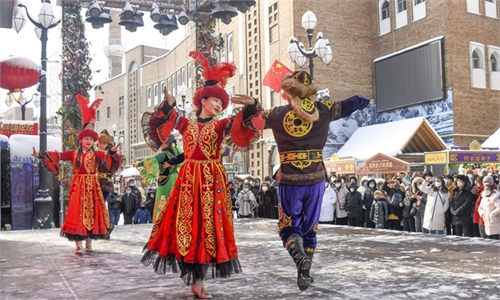Operating hot pot restaurant and wearing colorful dresses: How feminism has been growing in Xinjiang

Photo: CFP
When you search the term "Xinjiang women" on the internet, there will be loads of results on "forced labor," "forced sterilization" and "persecution." It presents a misconception that the women in Xinjiang are vulnerable, oppressed and victims. However, my experience and research in Xinjiang reveals an opposite reality. In the past decade, I witnessed the rapid emancipation and modernization of Xinjiang women in an unprecedented speed, and the feminism has grown in a unique, powerful, and inspiring way in Xinjiang.
Since 1950s, the emancipation of the women had become a national strategy in China, and all Chinese women quickly escaped from being discriminated, oppressed, and even enslaved, and feminism in Xinjiang emerged. Especially in urban areas, for the first time in history, women shattered the restraints imposed by traditional social order and value systems and gained equal rights to politics, law, education and employment. They rapidly adopted modern lifestyles and found their position in the market economy. However, in some southern rural areas, due to the highly closed nature of society and economic underdevelopments, a large proportion of women were tied to family and engaged in both heavy domestic work and work on farms or animal husbandry, without access to the market. Besides these general female dilemmas, they were also constrained by overwhelming cultural traditions and unable to develop self-consciousness and independence, as evidenced by low social status and high fertility rates. I named this as a "partial feminism" period.
In the early 21st century, when feminism prevailed in most parts of China, it fell into a trough in Xinjiang due to multiple reasons including a global revival of religion and extremism. Some women who had not completed the aforementioned modernization then became the target of the extremism ideas. I strongly recommend you search online a video called "100 years of Uyghur Fashion" which was made by a young man from Kashi. It shows minority women in Xinjiang had been dressing in a beautiful and colorful way since last century. However, in the first few years of the 21st century, women in some small towns in southern Xinjiang can be seen wearing whole black robes. This confusing change was the symbol of "de-feminism" process in this period.
Until 2010, Xinjiang entered a new stage which I refer to as the "re-feminism" period. As China's economy continued high-speed growth, and 19 provinces and cities began to provide pairing assistance to Xinjiang, Xinjiang's development has been accelerated. Several labor-intensive industries had been introduced to Xinjiang, such as textiles, modern agriculture, and electronics assembly, which provided numerous jobs for women. Language and job skill training program and micro-loans enabled capable women to start their own businesses. More importantly, education, including extending free education to 15 years, increasing universities and occupational schools, brings a thorough transformation to the mind of Xinjiang women.
Compared to the first stage, feminism at this stage has two distinct features. One is that women are no longer objects to be given opportunities and waiting to be liberated by men or the outside world, but take actions by themselves and are self-empowered. They resist the traditional thoughts referring to gender inequality, marriage, family, and childbirth, and refuse to be defined by procreation, restrained by male family members and invisible in public life anymore and ask for new roles. Second, they don't abandon their own cultural origin for assimilation. Instead, they enjoy the right to make their own choice and find balance between individual rights and community responsibilities, between modern values and cultural heritage, and between changing and staying the same, willingly, informed, and free.
I made a lot of female friends in Xinjiang, and they told me lots of inspiring stories of how far they have come. For example, in Shaya county, Aksu, a 53-year-old Uygur woman, despite family members disagreement, opened the first restaurant in the county to combine Sichuan hot pot with ethnic food habits, and made a fortune. Actually, being an entrepreneur is one of the most popular roles women in Xinjiang pursue. Meantime, women from the same and different generations, based on the long-standing tradition of women mutual supporting in Xinjiang, have formed formal and informal sisterhoods and networks.
They go to bars together and provide each other with financial donations, emotional support, legal assistance, and other resources when members encounter problems. Colorful silk dresses, jeans and suits are back to the streets of cities and villages, women become the most potential, vibrant and creative members of Xinjiang.
The United Nations Human Rights Council (HRC) aims to discuss an extensive range of topics related to promotion and protection of all human rights around the globe. But some countries have attempted to mislead the agenda of HRC with their political and false narratives. I think it is unfair and even cruel to 12.5 million Xinjiang women whose efforts to fight for their rights as members of modern society haven't been seen. I wish people around the world can pay more attention to Xinjiang and discover the other and true side of women in Xinjiang.
The author is a lecturer at School of Politics and lnternational Relations, Lanzhou University. opinion@globaltimes.com.cn

